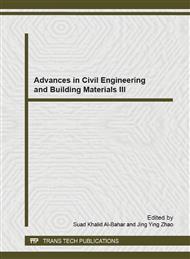[1]
P. K. Robertson and K. L. Cabal (Robertson). Guide to Cone Penetration Testing for Geotechnical Engineering[M]. Gregg Drilling & Testing, Inc. 2010: 6.
Google Scholar
[2]
Li Guangxin. Advanced soil mechanics[M]. Beijing, Tsinghua University Press. 2004: 20–21, in Chinese.
Google Scholar
[3]
Wan Guangchen, Chen Jian, Zhu Qi. Applications of Technical Achievements in Cone Penetration Test in Engineering [J]. Railway Investigation and Surveying,2011, 1: 37-40, in Chinese.
Google Scholar
[4]
Liu Yongxue, Peng Guoping, Meng Fanfu. Application of Static Cone Penetration Test in Geotechnical Engineering Investigation [J]. Forestry Science and Technology Information, 2003, 35(2): 78-80, in Chinese.
Google Scholar
[5]
Xu Hua. Application of Pore Water Pressure Static Cone Penetration Test in Shanghai area[J]. Geotechnical Engineering Technique, 1999, 3: 57-59, in Chinese.
Google Scholar
[6]
Zhou Jingxing, Li Guangxin, Yu Shimin, Wang Hongjin. Foundation Engineering (2)[M]. Beijing, Tsinghua University Press. 2007: 162-165, in Chinese.
Google Scholar
[7]
Zhou Shengen. Evaluation of the Liquefaction of Sand by Static Cone Penetration Test [J]. Chinese Journal of Geotechnical Engineering,1980, 2(3): 38-45, in Chinese.
Google Scholar
[8]
Wu Daoxiang, Shan Cancan, Zhong Xuanming, Wang Guoqiang. Development of CPT and its application in geotechnical engineering [J]. Journal of Hefei University of Technology (Natural Science), 2008, 31(2): 211-215, in Chinese.
Google Scholar
[9]
Jian Wenbin, Wu Zhenxiang, Tong Wende, Liu Huiming, Zhang Minxia. Consolidation State of Soft Soil Differentiated by Static Cone Sounding [J]. Chinese Journal of Rock Mechanics and Engineering, 2005, 24(12): 2166-2169, in Chinese.
Google Scholar
[10]
Bolton, M. D., Gui, M. W. and Philips, R. Review of miniature soil probes for model tests[J]. Eleventh Southeast Aisan geotechnical conference 4-8 May, 1993, Singapore: 85-90.
Google Scholar
[11]
Yu, H. S., Mitchell, J. K., Analysis of cone resistance: review of methods[J]. Journal of Geotechnical and Geoenvironmental Engineering, ASCE, 1998, 124(2): 140-149.
DOI: 10.1061/(asce)1090-0241(1998)124:2(140)
Google Scholar
[12]
Bolton, M. D., Gui, M. W., Garnier, J., Corte, J. F., Bagge, G., Laue, J. and Renzi, R. Centrifuge cone penetration tests in sand [J]. Géotechnique, 1999, 49(4): 543-552.
DOI: 10.1680/geot.1999.49.4.543
Google Scholar
[13]
Gui, M. W., Bolton, M. D., Garnier J., Corte, J. F., Bagge, G., Laue, J. and Renzi, R. Guidelines for cone penetration tests in sand [J]. Centrifuge 98, Kimura, Kusakabe & Takemura(eds), 1998 Balkema, Rotterdam, 155–160.
DOI: 10.1680/geot.1999.49.4.543
Google Scholar
[14]
Y. Du, S. Zhu, L. Han and L. Ru. LXJ-4-450 Geotechnical centrifuge in Beijing [C], Centrifuge 94, Singapore, Balkema, pp.35-39.
Google Scholar
[15]
Y.J. Hou, Y.F. Wen, X.D. Zhang, Q.L. Sun, C. Gauffre, P. Sabard1 and D. Rames. Development of IWHR Centrifuge Controlled Tools System[C]. Proceedings of the First Asian Workshop on Physical Modelling in Geotechnics, 2012: 119-124.
Google Scholar


